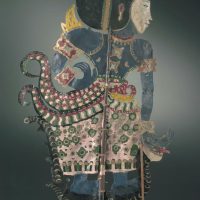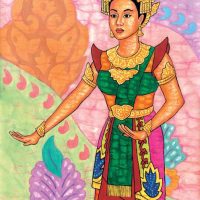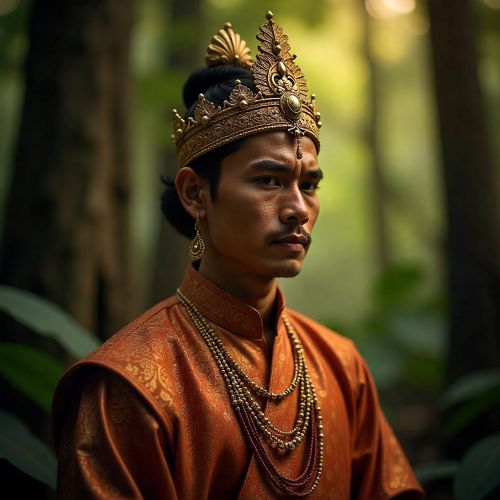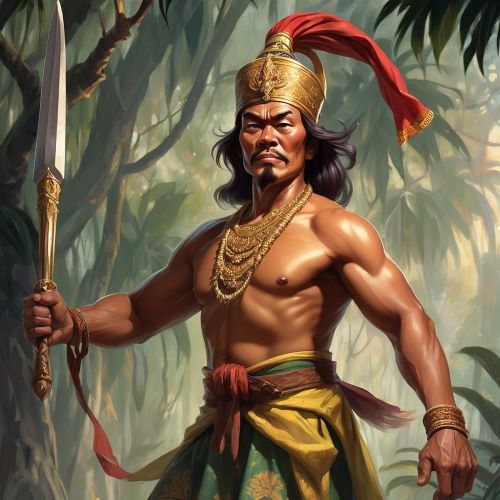Siti Dewi : The Malay Heroine of the Hikayat Seri Rama Tradition
Listen
At a glance
| Description | |
|---|---|
| Origin | Malaysian Mythology |
| Classification | Mortals |
| Family Members | Seri Rama (Husband), Maharaja Wana (Father) |
| Region | Malaysia |
| Associated With | Royalty, Virtue |
Siti Dewi
Introduction
Siti Dewi occupies a deeply respected place in Malaysian mythology, especially within the world of Wayang Kulit Kelantan, where the Malay adaptation of the Ramayana—Hikayat Seri Rama—has shaped her identity. While she is rooted in the figure of Sita from the Indian epic, Siti Dewi evolves into a distinctly Malay heroine, embodying the cultural values, spiritual depth, and social ideals of the Nusantara world. Her story explores devotion, endurance and the unshakeable moral courage she displays when confronted with adversity. Through her, the Ramayana transforms from an imported epic into a tapestry of Malay aesthetics, beliefs and ethical teachings, making Siti Dewi a timeless symbol of purity, inner strength and dignity within Southeast Asian cultural heritage.
Physical Traits
Siti Dewi is consistently portrayed with an ethereal charm that mirrors her spiritual purity. Traditional texts and wayang kulit carvings describe her as possessing luminous beauty, serene facial features and an air of gentle refinement. Her puppet form in Wayang Kulit Kelantan reflects these qualities through slender lines, fine detailing and elegant royal attire, reinforcing her status as a woman of divine grace. The delicacy of her movements in performance—guided by the puppeteer—creates an impression of weightlessness and composure, highlighting her calm presence even during moments of turmoil. This combination of visual elegance and inner virtue positions Siti Dewi as the embodiment of perfect femininity in Malay cultural imagination.
Family
Siti Dewi’s lineage differs significantly from the classical Indian Ramayana, reflecting the Malay tradition of adapting myths into their own cultural frameworks. In many Malaysian retellings, she is not simply the daughter of King Janaka, but instead emerges from a supernatural origin that deepens her mystique. Some Kelantanese versions describe her as the daughter of Maharaja Wana (Ravana) and Mandodaki—created through mystical means—before being discovered by the sage Maharisi Mata Api and his wife Minuram Dewi. This origin links her both to the celestial world and to human adoptive parents, enriching her role in the narrative as a bridge between realms. Her marriage to Seri Rama further extends her position within a web of mythic relationships that define her life’s trials and triumphs.
Other names
The name Siti Dewi itself reflects her assimilation into Malay culture, as “Siti” is a common female honorific in the region. In Indian tradition she is known as Sita, while in Malay texts she may appear as Sita Dewi, reinforcing her connection to the broader Ramayana universe. In some parts of the Malay Archipelago—especially areas influenced by Javanese cosmology—she is linked to Dewi Sri, the goddess of rice and fertility. Although this association differs from the Ramayana narrative, the thematic overlap of purity, nurturance and renewal shows how Southeast Asian cultures merged multiple mythic traditions into a coherent, localized worldview. These diverse identities demonstrate Siti Dewi’s flexibility as a cultural figure, reflecting regional variations in belief and storytelling.
Powers and Abilities
Siti Dewi’s strengths lie in her moral and spiritual fortitude rather than in any form of physical or magical combat. Her defining power is her unyielding purity, which enables her to resist temptation, endure captivity and remain emotionally resilient in the face of overwhelming adversity. In some localized legends, her suffering leads to spiritual manifestations—miraculous events or natural blessings—symbolizing her connection to life, fertility and moral renewal. Her ability to inspire unwavering loyalty from Seri Rama and others highlights her symbolic role as the moral heart of the narrative. Through endurance, integrity and devotion, Siti Dewi’s inner power drives the story’s emotional and ethical core.
Modern Day Influence
The influence of Siti Dewi remains deeply embedded in Malaysian cultural life. In the Wayang Kulit Kelantan, she continues to be a central figure whose trials are retold to transmit traditional values to new generations. Her story also features prominently in textbooks, literature and academic research exploring Southeast Asian adaptations of the Ramayana. Modern storytellers often reinterpret her endurance as a form of agency, re-examining her choices and emotional strength through contemporary perspectives on womanhood. Her character inspires artists, playwrights and cultural custodians who use her narrative to maintain connections to Malaysia’s mythic and theatrical heritage. In rituals celebrating rice, fertility or community well-being, echoes of the Dewi Sri connection can sometimes be felt, demonstrating how her symbolic presence transcends strict narrative boundaries. Today, Siti Dewi stands not only as a mythic heroine but also as a cultural touchstone reflecting both tradition and evolving interpretations of femininity and strength.
Related Images
Source
Ghulam-Sarwar Yousof. (2015). Southeast Asian Adaptations of the Ramayana and their Performing Arts Contexts. Malaysian Journal of Performing and Visual Arts, 1, 39–51. https://ejournal.um.edu.my/index.php/MJPVA/article/download/2042/376/6923
Harshananda, Swami. (2012). A Concise Encyclopaedia of Hinduism. Bangalore: Ramakrishna Math.
Sweeney, A.P.L. (1972). The Rama Saga and the Malay Shadow Play. Kuala Lumpur: The National University of Malaysia Press.
Zieseniss, A. (1963). The Rama Saga in Malaysia, Its Origin and Development (P. W. Burch, Trans.). Singapore: Malaysian Sociological Research Institute.
Muniandy, R. (1995). Hikayat Seri Rama: Perbandingan Versi Melayu, Sanskrit dan Tamil. Kuala Lumpur: Dewan Bahasa dan Pustaka.
Fan, P. (2021, March 7). The indomitable ‘semangat’ of Kelantanese women. The Vibes. Retrieved from https://www.thevibes.com/articles/culture/19712/the-indomitable-semangat-of-kelantanese-women
Khor, K. K. (2017). Wayang Kulit Kelantan: A study of characterization and puppets. Asian Theatre Journal, 34(1), 45–67. https://doi.org/10.1353/ATJ.2017.0002
Kápoia tychaía períerga. (2020, June 22). Wayang Kulit characters in Malaysia. Retrieved from https://capoiatychaiaperierga.blogspot.com/2020/06/wayang-kulit-characters-in-malaysia.html
“Dewi.” (2002, September 15). In Wikipedia. Retrieved from https://en.wikipedia.org/wiki/Dewi
Representation of Stories Associated with Malay Myths and Legends in the Mass Media. (2015). In Proceedings of ICOMHAC2015 (pp. 457–459). Pulau Langkawi: UiTM Kedah
Frequently Asked Questions
Who is Siti Dewi in Malaysian mythology?
Siti Dewi is the Malay adaptation of Sita from the Ramayana, revered for her purity, resilience and central role in the Hikayat Seri Rama.
Is Siti Dewi the same as Sita?
She is based on Sita, but her character and origins are adapted to fit Malay cultural, spiritual and theatrical traditions.
What is Siti Dewi known for?
She is known for her moral strength, loyalty to Seri Rama and her symbolic representation of virtue and feminine grace.
How does Siti Dewi appear in Wayang Kulit Kelantan?
She is depicted with delicate features, elegant attire and stylised proportions that reflect her noble and divine qualities.
Why is Siti Dewi important in modern Malaysian culture?
She remains a key figure in performing arts, literature and cultural studies, representing both tradition and enduring moral values.











